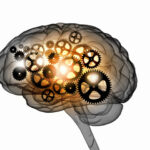
Ask your child when he or she is 4 years old to draw a picture of a child. Once your child has complied, the drawing could be scored on a scale of 0 to 12. The scoring depends upon the features included and if they are correct in number and in placement. The scored features can include head, body, eyes, mouth, ears, nose, hair, arms, and legs. In one scoring example, a child whose drawing has a body, a head, two arms, and two legs that are all correctly placed but does not include any facial features would receive a score of 4.
The “Draw-A-Person” Test For Intelligence
This test is called the Draw-a-Child or the Draw-a-Person test. It has also been called the Goodenough-Harris test. Dr. Rosalind Arden was the lead author in a study involving drawing and intelligence. Dr. Arden and researchers from King’s College London recently studied 7,752 pairs of identical and non-identical twins to determine if the link between drawing and later intelligence was influenced by their genes. The study took place in the MRC Social, Genetic, and Developmental Psychiatry Centre at the Institute of Psychiatry at King’s College London.
Dr. Arden said, “The Draw-a-Child test was devised in the 1920’s to assess children’s intelligence, so the fact that the test correlated with intelligence at age 4 was expected. What surprised us was that it correlated with intelligence a decade later.” She continued, “The correlation is moderate, so our findings are interesting, but it does not mean that parents should worry if their child draws badly. Drawing ability does not determine intelligence, there are countless factors, both genetic and environmental, which affect intelligence in later life.”
This test was developed by Florence Goodenough in 1926. Later on, the test was revised by Dr. Dale B. Harris. Along with testing children for intelligence, the test is also given to some people who are suspected of having a mental illness, particularly those who may have schizophrenia. In the case of adults, they are typically asked to draw a person rather than to draw a child. According to psychologist Julian Jones and his 1976 book, The Origin of Consciousness in the Breakdown of the Bicameral Mind, schizophrenic patients do not always have trouble drawing a person. If the patient in question cannot draw a person or has difficulty drawing a person, he or she is likely to have a mental illness. Some patients will draw exaggerated features or have trouble with different pieces of the body. Any of these difficulties can tell trained psychiatrists about the condition from which the patient is suffering.
Studies Done Between Twins Prove Effectiveness
Twins were used in the King’s College study to add an element of heritability to the research. Non-identical twins share approximately 50 percent of their genes. Identical twins share 100 percent of their genes. Twins were chosen who were being raised in the same home, under the same conditions, with the same family environment, and access to the same materials so that the genetic factors would be the most apparent variables.
According to the research, the drawings of the 4 year olds who are identical twins were more similar to one another than the drawings done by the non-identical twins. Researchers concluded from this that the differences in each child’s drawings would likely be a genetic factor. They also found a strong genetic link between the score of the drawing produced at the age of 4 and the intelligence of the child at the age of 14.
Dr. Arden clarified, “This does not mean that there is a drawing gene — a child’s ability to draw stems from many other abilities, such as observing, holding a pencil etc. We are a long way off understanding how genes influence all these different types of behavior.”
Dr. Arden continued, “Drawing is an ancient behavior, dating back beyond 15,000 years ago. Through drawing, we are attempting to show someone else what’s in our mind. This capacity to reproduce figures is a uniquely human ability and a sign of cognitive ability, in a similar way to writing, which transformed the human species’ ability to store information, and build a civilization.”




